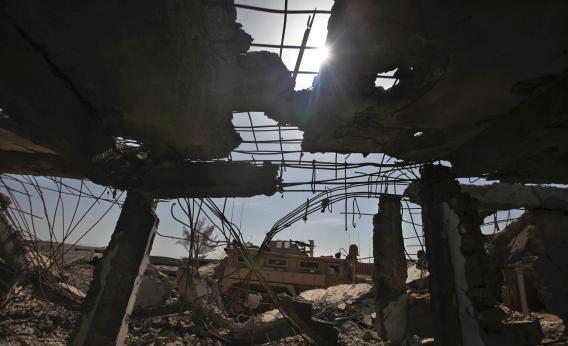I just finished reading The Better Angels of Our Nature: Why Violence Has Declined, in which Steven Pinker argues that violence in all forms has diminished over the past few centuries. That’s good for people, of course, but it got me thinking about the environment. How does war affect the planet?
Research on this issue is pretty thin. The human and financial costs of armed conflict are so vast that few people have stopped to consider what war does to rivers, trees, and elephants. In recent years, academics have been much more interested in how environmental degradation contributes to war than in how wars degrade the environment. In addition, no two wars affect the planet in the same way. The environmental devastation from a nuclear war, for example, would be difficult to estimate in advance.
Sticking to nonnuclear conflict, there are a few general points that can be made. Some of the more environmentally damaging military tactics have been banned. For example, destroying the forest canopy with chemical defoliants—a tactic the U.S. military used extensively in Vietnam—is now a violation of the Chemical Weapons Convention.
Conventional weapons don’t pose as direct a threat to ecosystems. They contain some scary chemicals, including ammonium nitrate, ethylene oxide, white phosphorous, and TNT. But, when a bomb detonates, those substances don’t travel very far. A United Nations study following the conflict in Bosnia found little evidence of crop and groundwater contamination by depleted uranium, which is common in armor-piercing munitions. At 50 or 60 yards from the site of impact, the chemical had become so diluted that it posed no serious danger to humans or animals.
The real risk that conventional weapons pose to the environment is through indirect effects. In May 1943, for example, Royal Air Force pilots blew up a pair of German dams. The resulting flood destroyed more than 7,000 acres of farmland, inundated 125 factories, and sent water rushing through several coal mines. U.S. forces used a similar tactic in the Korean War. In 1977, the Geneva Conventions were amended to ban the intentional breaching of dams in wartime, but only if the attack would cause “severe losses among the civilian population.” Environmental impacts are not mentioned.
Another major concern is the potential destruction of chemical facilities. Chemical plants today hold far larger volumes of dangerous substances than they used to. According to Czech toxicologist Jiri Matousek, the average sulfuric acid production plant in the 1950s generated around 10 tons of the chemical per day. By 1990, the average production had increased 200-fold, to 2,000 tons daily. The trains, trucks, and pipelines that carry our dangerous chemicals have also increased their capacities.
One need only observe peacetime accidents to see what terror a bomb could unleash if dropped on a modern chemical factory. At the Union Carbide plant in Bhopal, India, in 1984, water infiltrated into a tank holding methyl isocyanate. The mixture caused an explosion that contaminated the surrounding area, killing thousands. Attacks on chemical plants are entirely possible. President Clinton ordered the bombing of a Sudanese factory in 1998 precisely because he thought it was stocked with dangerous chemicals.
Then there are the truly unfortunate incidents in which a desperate leader uses environmental terrorism as a military tactic. The most famous example is Saddam Hussein, who set fire to hundreds of oil wells on his way out of Kuwait in the first Persian Gulf War. He also dumped 11 million barrels of oil into the Gulf, the largest oil spill in history at the time. Oil lakes and thick deposits of tarcrete covered the area, and scientists found traces of oil in ants and sand lizards more than a decade later.
Warfare can have more subtle effects on the land than huge plumes of smoke. When Iraqi and American forces took turns crossing Kuwait in the early 1990s, they upset the natural gravel that holds the underlying soil in place. The result was accelerated wind erosion, a tenfold increase in sand dune formation, and consequent loss of vegetation that sustained the animals that occupied Kuwait’s desert and semi-desert regions.
Some of war’s impacts are even less direct. Many conservationists have noted that civil wars in Africa excluded park rangers and researchers from the field, leaving the already vulnerable gorilla populations exposed to poachers.
All of which brings us back to Steven Pinker’s book. Armies used to defeat each other by killing huge numbers of enemies in direct battle. Today, military strategists try to undermine the enemy’s war machine with less bloodshed. That usually means occupying huge swaths of land and destroying the industrial infrastructure. In other words, as war becomes safer for humans, it may be increasingly dangerous for the planet.
Is there an environmental quandary that’s been keeping you up at night? Send it to ask.the.lantern@gmail.com.
